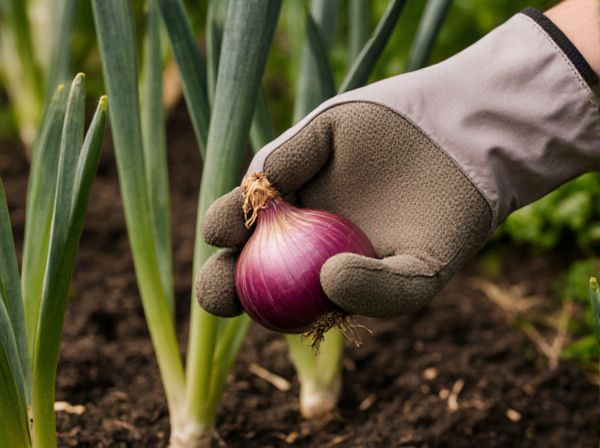
Short-day onions vs Long-day onions Illustration
Short-day onions thrive in regions with shorter daylight hours, typically under 12 hours of sunlight, making them ideal for southern climates and early planting. Long-day onions require 14 to 16 hours of daylight, growing best in northern regions with longer summer days to develop large bulbs. Understanding the photoperiod sensitivity of each type is crucial for successful onion cultivation and maximizing yield.
Table of Comparison
| Aspect | Short-Day Onions | Long-Day Onions |
|---|---|---|
| Daylight Requirement | 10-12 hours | 14-16 hours |
| Ideal Planting Season | Fall or Winter in Southern Regions | Spring in Northern Regions |
| Bulbing Trigger | Bulb formation starts with shorter daylight | Bulb formation starts with longer daylight |
| Common Growing Areas | Southern United States, mild climates | Northern United States, cooler climates |
| Harvest Time | 80-90 days | 100-120 days |
| Examples | 'Texas Super Sweet', 'Red Creole' | 'Walla Walla Sweet', 'Yellow Sweet Spanish' |
Understanding Short-Day and Long-Day Onions
Short-day onions initiate bulb formation when daylight reaches 10 to 12 hours, making them ideal for mild winter regions and early planting schedules. Long-day onions require 14 to 16 hours of daylight to bulb, thriving in cooler climates with extended summer days for optimal growth. Selecting the correct onion type based on day length ensures proper development, maximizing yield and flavor in specific seasonal conditions.
How Day Length Affects Onion Bulbing
Day length plays a crucial role in onion bulbing, determining when growth shifts from leaf development to bulb formation. Short-day onions require 10 to 12 hours of daylight to initiate bulbing, thriving in southern regions with milder winters and earlier planting seasons. Long-day onions need 14 to 16 hours of daylight, making them ideal for northern climates with longer summer days, ensuring optimal bulb size and quality.
Geographic Suitability: Where to Grow Each Type
Short-day onions thrive in southern regions with 10 to 12 hours of daylight, making them ideal for states like Texas, Georgia, and Florida. Long-day onions require 14 to 16 hours of daylight and are best suited for northern areas such as Oregon, Washington, and northern New York. Understanding the geographic suitability of these onion varieties ensures optimal bulb development and high yields.
Planting Seasons for Short-Day vs Long-Day Onions
Short-day onions thrive when planted in regions with shorter daylight hours, typically during late winter to early spring, as they begin bulb formation when daylight is 10-12 hours. Long-day onions require planting in early spring in northern latitudes where daylight extends to 14-16 hours, promoting bulb development under longer daylight conditions. Proper alignment of planting time with the onion type's photoperiod sensitivity ensures optimal growth and bulb size.
Varietal Choices: Popular Short-Day and Long-Day Onions
Short-day onions such as 'Vidalia', 'Texas Super Sweet', and 'Granex' thrive in regions with shorter daylight hours, typically under 12 hours, making them ideal for southern climates. Long-day onions like 'Walla Walla', 'Copra', and 'Candy' require 14 to 16 hours of daylight, favoring northern regions and cooler growing seasons. Choosing the correct variety based on day length ensures optimal bulb development and maximum yield.
Yield and Size Differences Explained
Short-day onions develop bulbs when daylight lasts around 10-12 hours, resulting in smaller but earlier maturing onions ideal for southern regions with milder climates. Long-day onions require 14-16 hours of daylight, producing larger bulbs favored in northern regions with longer summer days, often yielding a higher total crop weight. Understanding these photoperiodic differences helps optimize onion yield and size by matching the variety to the local growing season length.
Flavor Profiles: Comparing Short-Day and Long-Day Onions
Short-day onions, grown in regions with shorter daylight hours, tend to have a sweeter, milder flavor ideal for fresh salads and light cooking. Long-day onions, cultivated in areas with extended daylight periods, develop a more pungent, robust taste suitable for caramelizing and hearty dishes. Flavor profiles of these onions vary significantly due to their photoperiod sensitivity, affecting sulfur compound development and resulting in distinct culinary uses.
Care and Maintenance Tips for Each Type
Short-day onions, thriving in mild climates with 10-12 hours of daylight, require well-drained soil rich in organic matter and consistent watering to prevent bulb splitting. Long-day onions, suited for northern regions with 14-16 hours of daylight, benefit from deep soil cultivation and periodic nitrogen feeding to support robust bulb growth. Regular weed control and timely harvesting are crucial for both types to ensure optimal yield and flavor.
Harvest Timing: When to Pull Short-Day vs Long-Day Onions
Short-day onions are typically harvested 90 to 120 days after planting, thriving in regions with 10 to 12 hours of daylight during the growing season, making them ideal for southern latitudes. Long-day onions require 14 to 16 hours of daylight to bulge properly and are usually ready for harvest around 100 to 120 days after planting, suitable for northern climates with longer summer days. Precise timing for pulling onions depends on neck softening and foliage yellowing, signaling maturity specific to each onion type's photoperiod sensitivity.
Storage Longevity: Which Onion Lasts Longer?
Short-day onions typically have a shorter storage life of around 2 to 3 months due to their higher moisture content and thinner skins. Long-day onions, known for their firmer texture and thicker skins, can be stored for 6 to 8 months under optimal conditions. Proper curing and cool, dry storage environments significantly extend the longevity of long-day onions compared to short-day varieties.
Short-day onions vs Long-day onions Infographic

 gardendif.com
gardendif.com